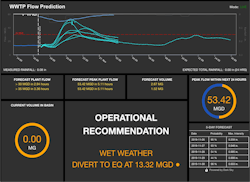Hydroinformatics: Redefining What’s Possible for Water Utilities
About the author:
To contact the WWD staff about this article, email [email protected].
As the water sector continues to scale smart water solutions, hydroinformatics is a powerful force helping utilities to transform how they manage water.
What is Hydroinformatics?
Hydroinformatics engineers combine multidisciplinary experience with optimization and hydraulic modeling skills, a deep understanding of the water cycle and a passion for using data to improve the urban watershed for local communities. They leverage expertise from traditional civil and environmental engineering disciplines, machine learning, control theory, and even sociotechnical systems, to maximize the potential of digital technologies and identify innovative approaches to solve age-old challenges.
Hydroinformatics engineers develop and implement algorithms and analytics that give water operators more visibility into system performance, to help prevent disruptions, identify efficiencies and make better decisions. They analyze challenges to devise custom, highly configured algorithmic solutions and help implement, test and refine them to create a real-time decision support system.
RELATED: How to Create an I&I Model
By comparing the utility’s day-to-day performance against historical data, these engineers help water operators detect and even predict events, and discover new ways to deliver water, energy, and cost savings.
As climate change impacts and environmental issues escalate, hydroinformatics engineers play an even more critical role in redefining the possibilities for water.
To discover more about hydroinformatics, Water & Wastes Digest spoke to Bryant McDonnell, senior manager of Hydroinformatics and Process Control at Xylem to discuss how his team is moving the dial for utilities, empowering them to deliver remarkable cost savings and new levels of efficiency and control.
How do Hydroinformatics Work for Utilities?
WWD: Bryant, explain how you are putting hydroinformatics to work for utilities.
McDonnell: Utilities are under pressure to be more operationally and financially resilient and digital technologies can help deliver safe, compliant, reliable, and affordable water to their communities. That’s where our team and our digital platform Xylem Vue comes in – to simplify this digital journey and maximize outcomes.
At its core, hydroinformatics is about looking at problems in a different way. We have assembled a global team of experts from diverse backgrounds and with the broadest skill set – from software and analytics, to applied civil and environmental engineering practices. This allows us to see water from a new perspective and help our clients to do likewise.
Utilities have an abundance of data but sometimes struggle to make sense of it or fully use it to their benefit. We help them to leverage their data to maximum effect by developing thousands of potential scenarios at scale which allows us to deliver critical insights and recommendations.
In practice, our team uses a combination of algorithms and machine learning to take large volumes of data and interpret them into actionable intelligence that utility leaders and operators can understand and use to make decisions. The algorithms we develop look at things like the energy optimization of a treatment plant or deliver real-time control strategies to reduce overflows in a sewer system, for example.
The Role of Hydroinformatics for Extreme Weather Events
WWD: We continue to see the impact of severe weather on communities around the world. How can hydroinformatics help utilities manage new challenges like increased rainfall?
McDonnell: Increasingly erratic weather patterns mean that utilities must now predict the unpredictable to ensure they can maintain continuity for their communities. Hydroinformatics can help. We partner with utilities to create virtual, real-time environments that analyze incoming data streams and, using advanced algorithms, provide strategies that help them manage the system during stressed times. For example, when it rains heavily in one part of the community, the algorithm responds to make sure that network assets are used optimally, and flows are well managed across the entire system.
How Can Water Utilities Implement Hydroinformatics?
WWD: Many utilities are in the early stages of their digital journey. How can hydroinformatics help their transformation?
McDonnell: The outcomes made possible by combining digital solutions and hydroinformatics are truly transformative. At Xylem, data-driven operational decision support is at the heart of what we do. We are increasingly partnering with utilities in deeper ways to provide end-to-end solutions.
We work with customers at every stage of their digital journey to understand the unique aspects of their system and community, to map the challenges and opportunities that lie ahead and to deploy the solutions that maximize those opportunities.
Real-World Hydroinformatic Outcomes
WWD: Tell us more about some of the real-world outcomes you are seeing as a result of hydroinformatics.
McDonnell: My favorite topic! Here are some examples:
- Partnering with the Buffalo Sewer Authority, we used technology to maximize the utilization of their existing network and drive the transformation of the city’s gravity sewer system into a managed conveyance and storage system. This real-time decision support system cut combined sewer overflows by 450 million gallons, delivering $145 million in savings to date from initial enforcement action.
- Xylem partnered with the Metropolitan Sewer District of Greater Cincinnati to reduce its sewer overflows. By leveraging the power of hydroinformatics to help coordinate control between assets, the city was able to reduce the overflow volume by roughly 250 million gallons per year at a cost of less than $0.01 per gallon. And this did not require any new infrastructure or major capital expenditure. It was simply a case of optimizing the existing system.
- Leveraging the same approach, the city of Evansville, Indiana, also reduced its sewer overflows by more than 100 million gallons a year. Using advanced optimization technology to effectively provide a software update to its existing system, the city was able to collect and analyze valuable data insights and convert its existing network into infrastructure that is more resilient and affordable.
Water challenges are escalating but utilities like these — and many more around the world — are showing innovative solutions can help visualize network behavior, optimize system performance and proactively protect their assets and communities.


